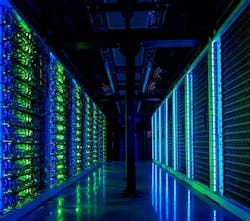The Switch SUPERNAP data centers are known for their bold color schemes, with mission-critical infrastructure painted red, blue and grey to identify the multiple power paths. But in 2016 Switch is thinking green, and has outlined immediate and long-term steps to use 100 percent renewable energy to support its colocation and cloud customers
As of January 1, the SUPERNAP data centers and their more than 1,000 clients are fully powered by renewable energy from NV Energy, the company said today. Later this year, Switch will tap more than 180 megawatts of solar farms in Nevada to supports its data centers. Switch says its commitment makes it the largest colocation data center environment to adopt 100 percent green technology.
“When I started Switch 16 years ago it was with a commitment to sustainably running the Internet,” said Rob Roy, the founder and CEO of Switch. “Switch has cemented itself as the leader of sustainability in the data center industry.”
The announcement from Switch is the latest milestone in renewable energy adoption by multi-tenant service providers. Hyperscale data center operators like Google, Facebook, Apple and Amazon have been the leading players in sourcing “green” electricity to power their massive data centers. But in recent months, colocation providers and wholesale data center operators have launched programs to incorporate more renewable energy into their operations. See our Executive Roundtable special, Energy Efficiency: Hyperscale vs. Multi-Tenant, for more on this trend.
Utility-Scale Solar Arrays
Switch is making a massive commitment to renewable power infrastructure, buying 180 megawatts of power from photovoltaic arrays in two huge solar generation projects in Nevada, dubbed Switch Station I and Switch Station II. The construction will be completed by First Solar in partnership with NV Energy.
The first project will be a 100 megawatt project north of Las Vegas. Switch will also use solar power to support its massive new data center project in Reno.
“We think it’s a big deal that we’re putting our renewables where our data centers are,” said Adam Kramer, executive vice president of strategy for Switch. Kramer noted that some data center providers purchase renewable energy credits, sometimes from renewable generation sources located outside the power grids that serve their data center facilities.
The company is not waiting for the solar farms to be completed to adopt greener energy. As of January 1, Switch says it is using renewable energy from existing generation sources in Nevada. Switch worked with NV Energy and the Nevada Public Utilities Commission to develop the NV Green Energy Rider tariff for southern Nevada, which taps NV Energy’s network of renewable generation resources – including geo-thermal, wind, hydro and solar – to deliver 100 percent green energy services to Switch.
Low Costs Support Green Tariff
High density data center racks deployed inside a SUPERNAP data center. (Photo: Switch SUPERNAP)
“Switch has set a new standard for using renewable resources to power their growing business,” said Paul Caudill, the President and CEO of NV Energy. “We are proud to partner with Switch to help it become the first southern Nevada customer to be supplied by 100 percent renewable energy. Switch’s leadership has opened the door for other large customers, including the City of Las Vegas, to meet their own renewable energy goals without negatively impacting the rates of other customers.”
Under the Green Tariff, first announced last July, Switch will pay a premium for the renewable power. But NV Energy’s costs will already be low, as the Switch Station I project will have perhaps the lowest costs of any project in the solar industry. NV Energy, a Berkshire Hathaway company, bought the output of the First Solar project for 3.87 cents per kilowatt hour. “That’s probably the cheapest PPA I’ve ever seen in the U.S.,” said Kit Konolige, a utility analyst at Bloomberg Intelligence.
The pricing reflects an important trend: solar power projects are becoming cheaper to build and operate. The integration of geothermal, wind and hydro generations sources is critical in providing 24×7 renewables, as the production of solar arrays is limited to daylight hours.
Switch isn’t alone in working with utility providers to arrange a green tariff powered by renewables, as Google developed a similar program in North Carolina with Duke Energy in 2013, and became its first customer.
The Multi-Tenant Challenge
Multi-tenant data center customers are focused on reliability and cost, and have historically been resistant to making any tradeoffs to source renewable energy. Attention from the NRDC and Greenpeace, which began ranking multi-tenant providers in its 2015 ranking of data center firms, has helped move the needle. Recently, corporate social responsibility programs have incentivized customers to consider “green” energy in their outsourced IT operations.
Equinix last year announced a sustainability program in which it plans to shift its entire global data center network of more than 100 facilities to run on clean and renewable energy. The company expects to have renewable sourcing for 82 percent of its capacity by the close of 2016.
Switch now houses 1.4 million square feet of mission-critical space on its Las Vegas campus across SUPERNAPS 7, 8 and 9. At full build-out, the Vegas campus will support 280 megawatts of IT capacity. Although its primary business is colocation, Switch has become an increasingly important player in cloud computing, with more than 120 cloud or managed service providers as customers.
Switch has announced plans for a 2 million square foot campus near Grand Rapids, Michigan and a 6.4 million SF development in Reno that will be the world’s largest data center campus.
About the Author


